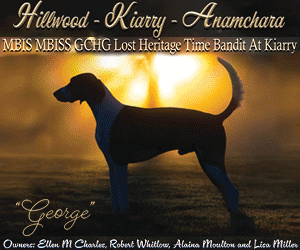Social Butterflies

By Amy Fernandez
Today I celebrated summer’s late arrival with a walk in our local park. Apparently every Queens resident had the same idea. It was packed. Worse yet, most of them wanted to pet my dog.
I’m certainly not immune to canine allure, and like most breeders, I take advantage of it to socialize puppies. But some dogs (and people) just don’t appreciate friendly strangers. On these occasions my Dachshund gives me his special “must I do this” look and resigns himself to the outcome. But he makes no polite pretense of enjoying it. While his admirers turn on the love tap, he stands there like he’s in line at the DMV, absolutely refusing to put on his happy face until we are safely out of petting range. Over the years, he’s perfected the dramatic aspects of this routine.
But lately, something has changed. Concerned strangers have begun offering advice to correct his social diffidence. Honestly, I’ve never considered it a problem. To me, it’s classic hound behavior. He’s completely absorbed his Dachshund world of mesmerizing scents, prospective prey, and the ubiquitous possibility of snacks. Friendly strangers rank very low on his list.

©Lisa Croft-Elliott
But these incidents have made me wonder when modern civilization decided that every dog should enjoy petting, hugging, and kissing from strangers. I must have skipped school that day because I recall no such lesson in my dog history class.
Formal research on the genetic aspects of temperament dates back to the early 1900s. It really got going during WWII when thousands of American pets were donated for military service. Some dogs did great, others failed miserably. A decade later, the ordeal was chronicled by Charence Pfaffenberger in The New Knowledge of Dog Behavior, the first book to examine the psychological components of canine behavior.
Frustrated by the lack of information available on canine temperament evaluation, Pfaffenberger turned to Scott and Fuller’s famous study at Hamilton Station in Bar Harbor, Maine. Throughout the 1950s they researched the mental development of five breeds from birth to 16 weeks. Their study focused on the impact of inherited behavior traits on human psychological development. They chose these particular breeds to represent the typical personality variations encountered within human populations. Tested under identical conditions, the study confirmed clear, predictable differences in their responses to learning, adaptability, and socialization. In other words, Wires, Cockers, Shelties, Beagles, and Basenjis were proven to have vastly different personalities way back then in 1946. Better yet, we all fall into one of those categories.
Since then, new information has enhanced our understanding of breed-based temperament traits. Both structural and chemical anatomy contributes to these unique neurological patterns, but they are all based in ancestral behavior sequences. Through domestication and selective breeding they have been isolated, reshuffled, and repackaged to tailor breeds for specific roles. They are subject to individual variation, but overall, breeds are genetically hardwired for certain responses. For instance, low levels of dopamine produce a calm, easygoing temperament. High levels are associated with the intensity and drive of working dogs. They love working because this activity stimulates the pleasure centers of their brains.

Every dog perceives the world through this inherent neurological lens. It influences every aspect of its demeanor, expression, and response. Maybe we’re not after boar or badger when my Dachshund resolutely drags me through woods, but I know he’s always hoping.
Trainers and pet owners should be mindful of this before judging canine behavior. But it also deserves more attention at dog shows. Thankfully, many breeds are rounding that treacherous curve of generic type but innate temperament doesn’t always receive the consideration it deserves in the show ring.
Short URL: http://caninechronicle.com/?p=26680
Comments are closed











